Nitrogen Deposition on Danish Nature
Abstract
:1. Introduction
2. Materials and Methods
2.1. Measurements
- Wet deposition of ammonium and nitrate.
- Concentrations of nitrogen compounds in gas and particle phase (ammonia, nitrogen dioxide, particulate ammonium, and the sum of gas phase nitric acid and particulate nitrate).
2.2. Model Calculations
3. Results
3.1. Atmospheric Loadings of Marine Waters
3.2. Atmospheric Loadings of Land Surfaces
3.3. Long-Term Trends in Atmospheric Nitrogen Deposition
3.4. Ammonia and the Nature Stations
4. Conclusions
Author Contributions
Acknowledgments
Conflicts of Interest
References
- Nilsson, J.; Grennfelt, P. Critical Loads for Sulphur and Nitrogen; Nordic Council of Ministers: Skokloster, Sweden, 1988; 488p. [Google Scholar]
- Bobbink, R.; Hicks, K.; Galloway, J.; Spranger, T.; Alkemade, R.; Ashmore, M.; Bustamante, M.; Cinderby, S.; Davidson, E.; Dentener, F.; et al. Global assessment of nitrogen deposition effects on terrestrial plant diversity: A synthesis. Ecol. Appl. 2010, 20, 30–59. [Google Scholar] [CrossRef] [PubMed] [Green Version]
- Stevens, C.J.; Dupre, C.; Dorland, E.; Gaudnik, C.; Gowing, D.J.G.; Bleeker, A.; Diekmann, M.; Alard, D.; Bobbink, R.; Fowler, D.; et al. Nitrogen deposition threatens species richness of grasslands across Europe. Environ. Pollut. 2010, 158, 2940–2945. [Google Scholar] [CrossRef] [PubMed] [Green Version]
- Maskell, L.C.; Smart, S.M.; Bullock, J.M.; Thompson, K.; Stevens, C.J. Nitrogen deposition causes widespread loss of species richness in British habitats. Glob. Chang. Boil. 2010, 16, 671–679. [Google Scholar] [CrossRef]
- Sutton, M.A.; Howard, C.M.; Erisman, J.W.; Billen, G.; Bleeker, A.; Greenfelt, P.; Grinsven, H.V.; Grizzetti, B. The European Nitrogen Assessment—Sources, Effects and Policy Perspectives; Cambridge CB2 8RU; Cambridge University Press: Edinburgh, UK, 2011; p. 612. [Google Scholar]
- Sutton, M.A.; Oenema, O.; Erisman, J.W.; Leip, A.; van Grinsven, H.; Winiwarter, W. Too much of a good thing. Nature 2011, 472, 159–161. [Google Scholar] [CrossRef] [PubMed]
- Danish Government. The Danish Aquatic Action Plan III. 2004. Available online: http://www.vmp3.dk/Files/Filer/English%20version/engelsk_oversaettelse.pdf (accessed on 14 November 2018).
- EEA. The European Environment—State and Outlook 2015: Synthesis Report; Publications Office of the European Union, The European Environment Agency: Luxembourg, 2015; p. 212. [Google Scholar]
- Dalgaard, T.; Hansen, B.; Hasler, B.; Hertel, O.; Hutchings, N.J.; Jacobsen, B.H.; Jensen, L.S.; Kronvang, B.; Olesen, J.E.; Schjorring, J.K.; et al. Policies for agricultural nitrogen management-trends, challenges and prospects for improved efficiency in Denmark. Environ. Res. Lett. 2014, 9, 115002. [Google Scholar] [CrossRef]
- Hertel, O.; Ellermann, T.; Palmgren, F.; Berkowicz, R.; Løfstrøm, P.; Frohn, L.M.; Geels, C.; Skjøth, C.A.; Brandt, J.; Christensen, J.; et al. Integrated air-quality monitoring—Combined use of measurements and models in monitoring programmes. Environ. Chem. 2007, 4, 65–74. [Google Scholar] [CrossRef]
- Nielsen, I.E.; Eriksson, A.C.; Lindgren, R.; Martinsson, J.; Nystrom, R.; Nordin, E.Z.; Sadiktsis, I.; Boman, C.; Nojgaard, J.K.; Pagels, J. Time-resolved analysis of particle emissions from residential biomass combustion Emissions of refractory black carbon, PAHs and organic tracers. Atmos. Environ. 2017, 165, 179–190. [Google Scholar] [CrossRef]
- Erisman, J.W.; Mennen, M.G.; Fowler, D.; Flechard, C.R.; Spindler, G.; Gruner, A.; Duyzer, J.H.; Ruigrok, W.; Wyers, G.P. Deposition monitoring in Europe. Environ. Monit. Assess. 1998, 53, 279–295. [Google Scholar] [CrossRef]
- Geels, C.; Andersen, H.V.; Skjoth, C.A.; Christensen, J.H.; Ellermann, T.; Lofstrom, P.; Gyldenkaerne, S.; Brandt, J.; Hansen, K.M.; Frohn, L.M.; et al. Improved modelling of atmospheric ammonia over Denmark using the coupled modelling system DAMOS. Biogeosciences 2012, 9, 2625–2647. [Google Scholar] [CrossRef] [Green Version]
- Hertel, O.; Geels, C.; Frohn, L.M.; Ellermann, T.; Skjoth, C.A.; Lostrom, P.; Christensen, J.H.; Andersen, H.V.; Peel, R.G. Assessing atmospheric nitrogen deposition to natural and semi-natural ecosystems—Experience from Danish studies using the DAMOS. Atmos. Environ. 2013, 66, 151–160. [Google Scholar] [CrossRef]
- Christensen, J.H. The Danish Eulerian hemispheric model—A three-dimensional air pollution model used for the Arctic. Atmos. Environ. 1997, 31, 4169–4191. [Google Scholar] [CrossRef]
- Frohn, L.M.; Christensen, J.H.; Brandt, J. Development and testing of numerical methods for two-way nested air pollution modelling. Phys. Chem. Earth 2002, 27, 1487–1494. [Google Scholar] [CrossRef]
- Brandt, J.; Silver, J.D.; Frohn, L.M.; Geels, C.; Gross, A.; Hansen, A.B.; Hansen, K.M.; Hedegaard, G.B.; Skjoth, C.A.; Villadsen, H.; et al. An integrated model study for Europe and North America using the Danish Eulerian Hemispheric Model with focus on intercontinental transport of air pollution. Atmos. Environ. 2012, 53, 156–176. [Google Scholar] [CrossRef]
- Olesen, H.R.; Berkowicz, R.; Løfstrøm, P. OML: Review of Model Formulation; NERI: Roskilde, Denmark, 2007; p. 130. [Google Scholar]
- Hertel, O.; Skjøth, C.A.; Løfstrøm, P.; Geels, C.; Frohn, L.M.; Ellermann, T.; Madsen, P.V. Modelling Nitrogen Deposition on a Local Scale—A Review of the Current State of the Art. Environ. Chem. 2006, 3, 317–337. [Google Scholar] [CrossRef]
- Skjøth, C.A.; Geels, C.; Berge, H.; Gyldenkærne, S.; Fagerli, H.; Ellermann, T.; Frohn, L.M.; Christensen, J.; Hansen, K.M.; Hansen, K.; et al. Spatial and temporal variations in ammonia emissions—A freely accessible model code for Europe. Atmos. Chem. Phys. 2011, 11, 5221–5236. [Google Scholar] [CrossRef] [Green Version]
- Gyldenkærne, S.; Skjøth, C.A.; Hertel, O.; Ellermann, T. A dynamical ammonia emission parameterization for use in air pollution models. J. Geophys. Res.-Atmos. 2005, 110, D7. [Google Scholar] [CrossRef]
- Skjøth, C.A.; Hertel, O.; Gyldenkærne, S.; Ellermann, T. Implementing a dynamical ammonia emission parameterization in the large-scale air pollution model ACDEP. J. Geophys. Res.-Atmos. 2004, 109, D6. [Google Scholar] [CrossRef]
- Fagerli, H.; Hertel, O.; Skjøth, C.A.; Gyldenkærne, S.; Hutchings, N. Implementation of a dynamical ammonia emission parameterization in the regional unified EMEP chemical transport model. In Proceedings of the Fourth Nitrogen Conference (N-2007), Costa do Sauípe, Brazil, 1–5 October 2007. [Google Scholar]
- Simpson, D.; Fagerli, H.; Jonson, J.E.; Tsyro, S.; Wind, P. Transboundary Acidification, Eutrophication and Ground Level Ozone in Europe, PART I, Unified EMEP Model Description; Norwegian Meteorological Institute: Oslo, Norway, 2003; pp. 1–104. [Google Scholar]
- Grell, G.A.; Dudhia, J.; Stauffer, D.R. A Description of the Fifth-Generation Penn State/NCAR Mesoscale Model (MM5); NCAR: Boulder, CO, USA, 1995. [Google Scholar]
- Brandt, J.; Christensen, J.H.; Frohn, L.M.; Berkowicz, R. Operational air pollution forecasts from regional scale to urban street scale. Part 1: System description. Phys. Chem. Earth Part B-Hydrol. Oceans Atmos. 2001, 26, 781–786. [Google Scholar] [CrossRef]
- Brandt, J.; Christensen, J.; Frohn, L.; Berkowicz, R.; Palmgren, F. The DMU-ATMI THOR Air Pollution Forecast System; Technical Report No 321; System Description: Roskilde, Denmark, 2000. [Google Scholar]
- Hertel, O.; Skjoth, C.A.; Frohn, L.M.; Vignati, E.; Frydendall, J.; de Leeuw, G.; Schwarz, U.; Reis, S. Assessment of the atmospheric nitrogen and sulphur inputs into the North Sea using a Lagrangian model. Phys. Chem. Earth 2002, 27, 1507–1515. [Google Scholar] [CrossRef]
- Nielsen, O.K.; Plejdrup, M.S.; Winther, M.; Mikkelsen, M.H.; Nielsen, M.; Gyldenkærne, S.; Fauser, P.; Albrektsen, R.; Hjelgaard, K.; Bruun, H.G.; et al. Annual Danish Informative Inventory Report to UNECE. Emission Inventories from the Year of the Protocols to Year 2015; Aarhus University: Aarhus, Denmark, 2017; 475p. [Google Scholar]
- Olesen, H.R.; Winther, M.; Ellermann, T.; Christensen, J.H.; Plejdrup, M.S. Ship Emissions and Air Pollution in Denmark: Present Situation and Future Scenarios; Danish Environmental Protection Agency: København, Denmark, 2009; 137p. [Google Scholar]
- Sommer, S.G.; Østergård, H.S.; Løfstrøm, P.; Andersen, H.V.; Jensen, L.S. Validation of model calculation of ammonia deposition in the neighbourhood of a poultry farm using measured NH3 concentrations and N deposition. Atmos. Environ. 2009, 43, 915–920. [Google Scholar] [CrossRef]
- Geels, C.; Ellermann, T.; Frohn, L.; Løfstrøm, P.; Christensen, J.H.; Hertel, O.; Gyldenkærne, S.; Skjøth, C.A.; Brandt, J.; Andersen, H.V.; et al. A coupled model system (DAMOS) improves the accuracy of simulated atmospheric ammonia levels over Denmark. Biogeosciences 2012, 9, 2625–2647. [Google Scholar] [CrossRef] [Green Version]
- UNECE. Empirical Critical Loads for Nitrogen—Expert Workshop, Berne, 11–13 November 2002; Environmental Documentation No. 164; UNECE: Geneva, Switzerland, 2003; p. 327. [Google Scholar]
- Klein, H.; Gauss, M.; Nyiri, A.; Benedictow, A. Transboundary Air Pollution by Main Pollutants (S, N, O3) and PM—Denmark; Norwegian Meteorological Institute: Oslo, Norway, 2018. [Google Scholar]
- Fagerli, H.; Tsyro, S.; Jonson, J.E.; Nyiri, A.; Gauss, M.; Simpson, D.; Wind, P.; Benedictow, A.; Valdebenito, A.; Klein, H.; et al. Transboundary Particulate Matter, Photo-Oxidants, Acidifying and Euthrophying Components; Norwegian Meteorological Institute: Oslo, Norway, 2018; p. 204. [Google Scholar]
- Cappelen, J.; Jørgensen, B.V. Danish Weather Since 1974—Month by Month with Temperature, Precipitation and Sun Hjours as Well as A Descrkiption of the Weather (In Danish: “Dansk vejr siden 1874—måned for måned med temperatur, nedbør og soltimer samt beskrivelser af vejret”); Danish Meteorological Institute: Copenhagen, Denmark, 2008; p. 10. [Google Scholar]
- Fowler, D.; Muller, J.; Smith, R.I.; Cape, J.N.; Erisman, J.W. Nonlinearities in source receptor relationships for sulfur and nitrogen compounds. Ambio 2005, 34, 41–46. [Google Scholar] [CrossRef] [PubMed]
- Schou, J.S.; Tybirk, K.; Løfstrøm, P.; Hertel, O. Economic and environmental analysis of buffer zones as an instrument to reduce ammonia loads to nature areas. Land Use Policy 2006, 23, 533–541. [Google Scholar] [CrossRef]
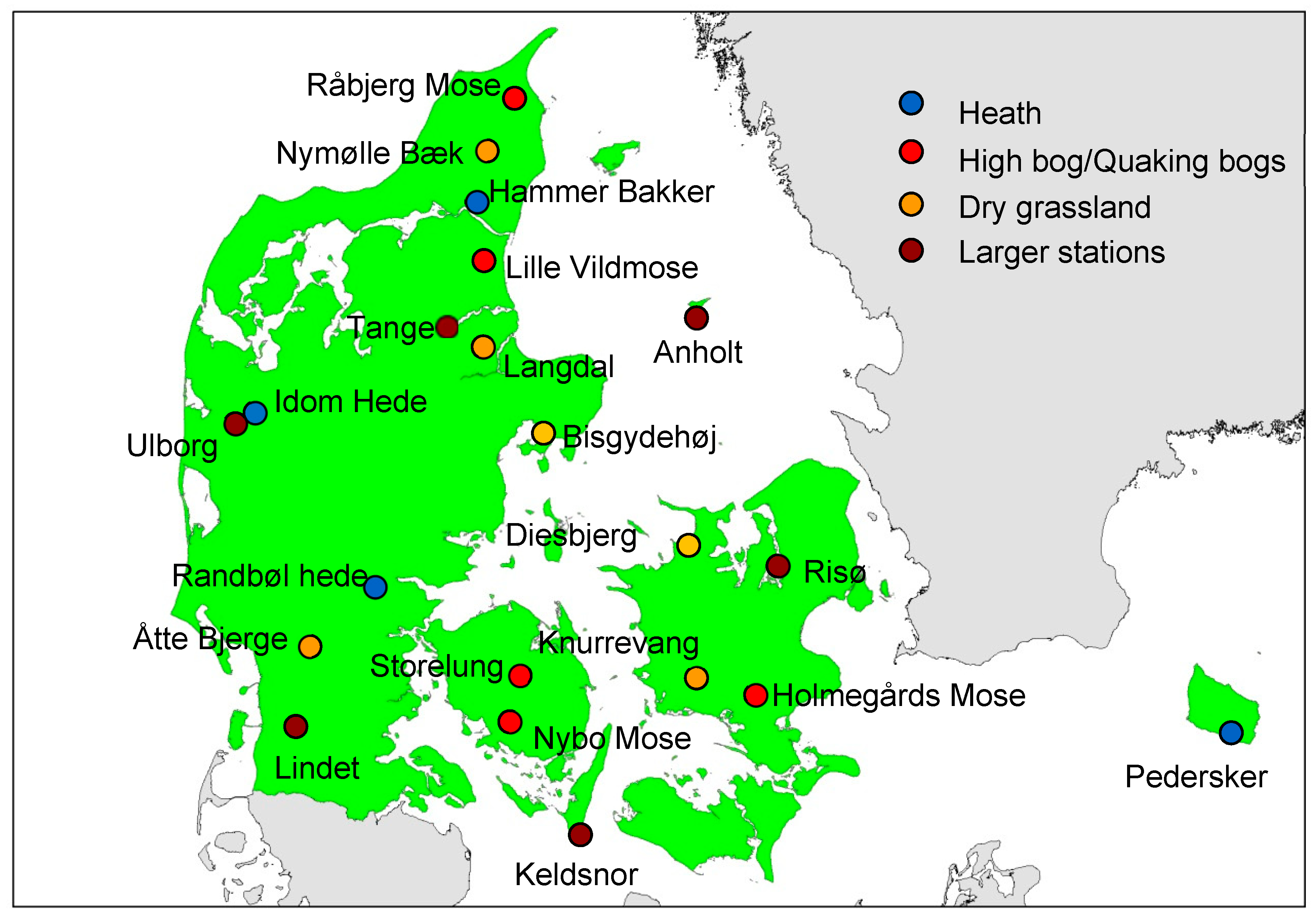
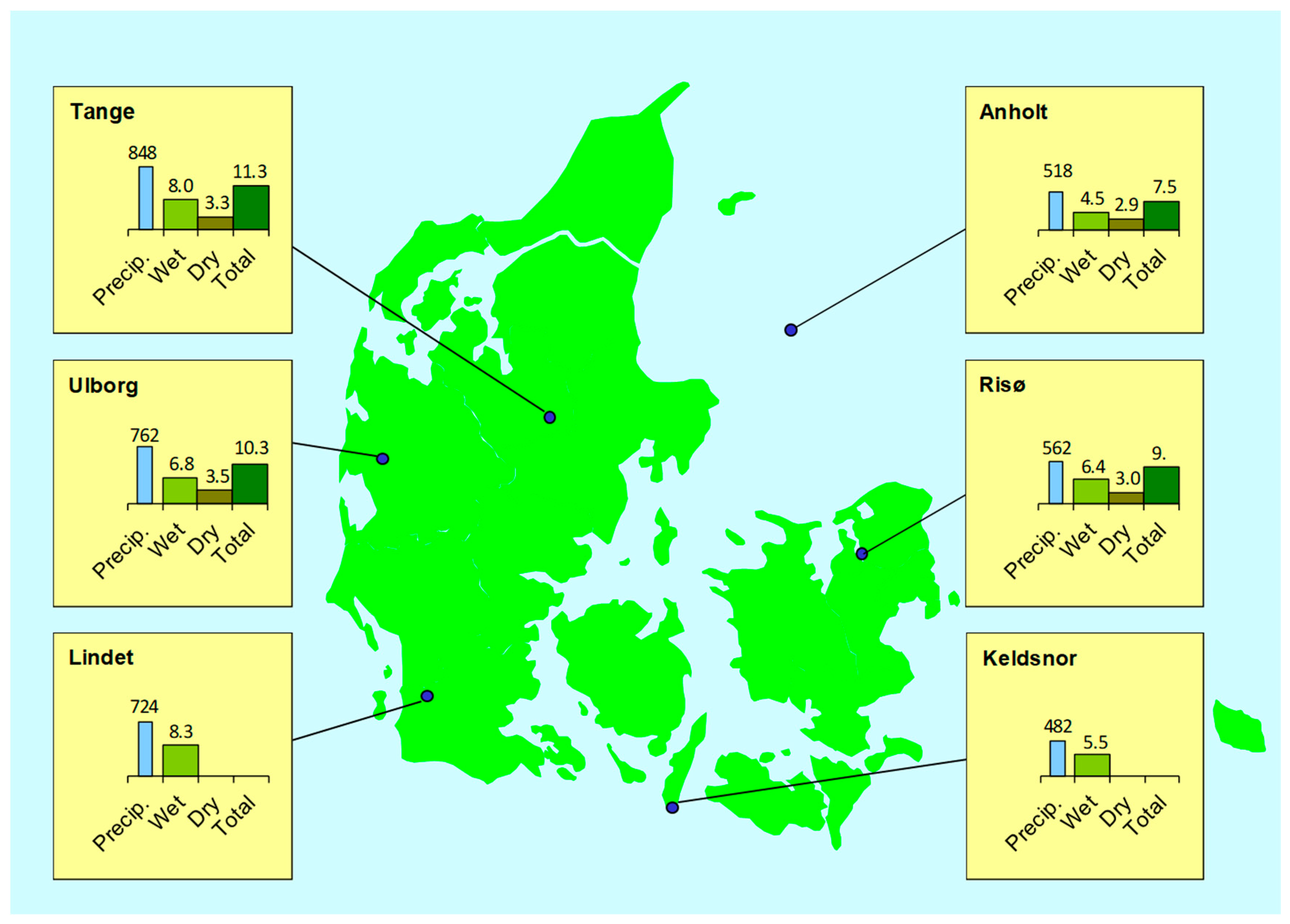
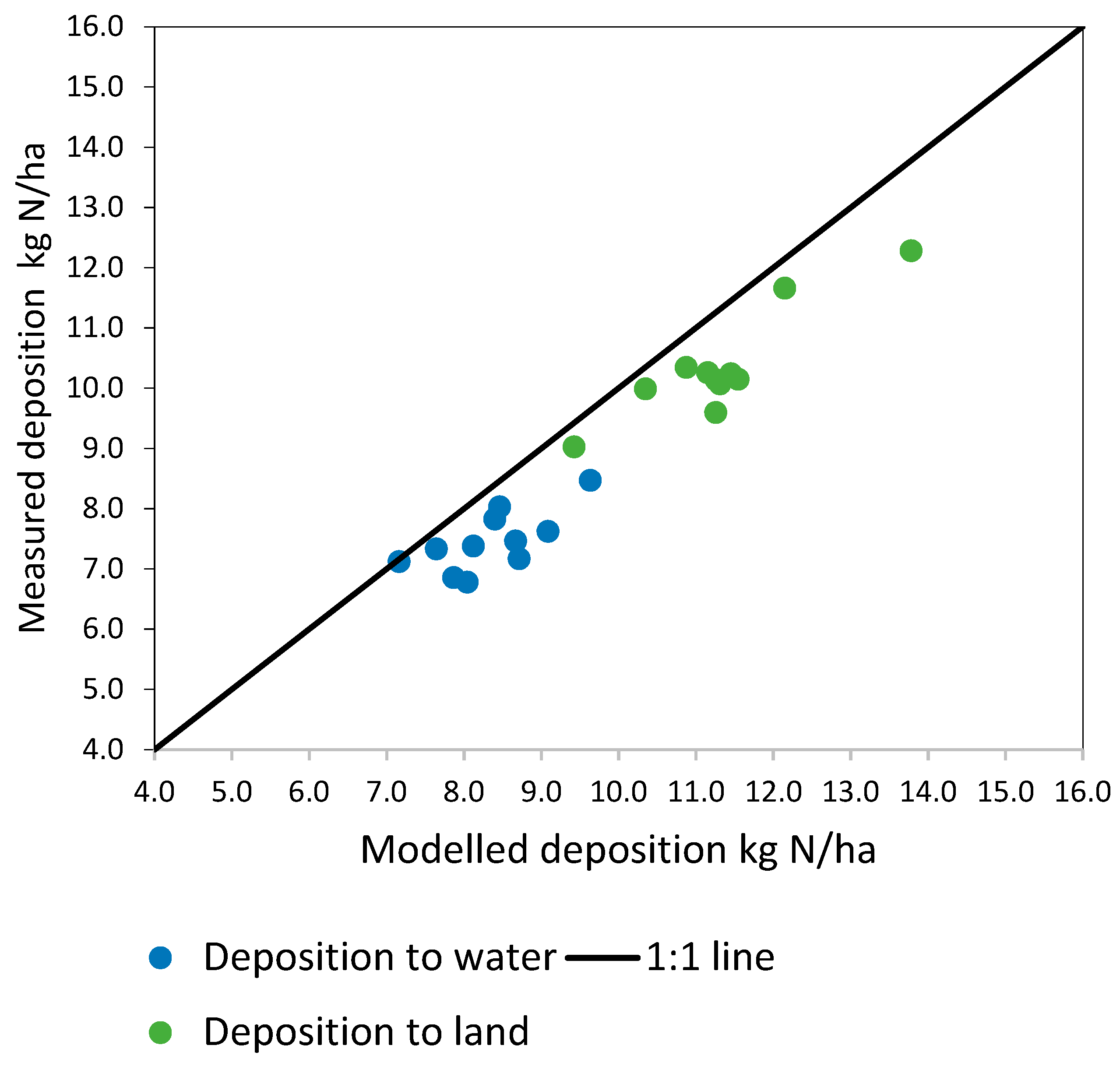
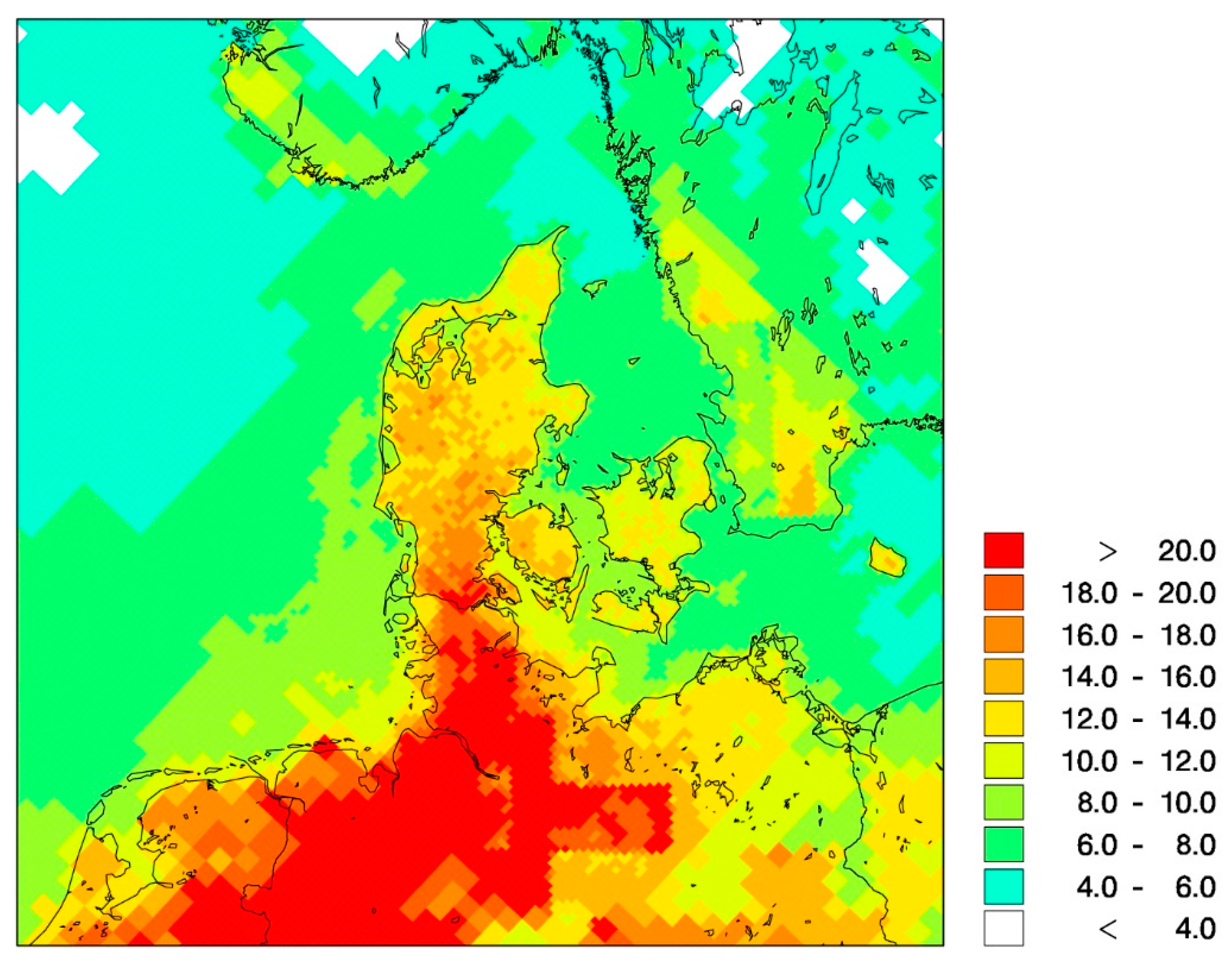
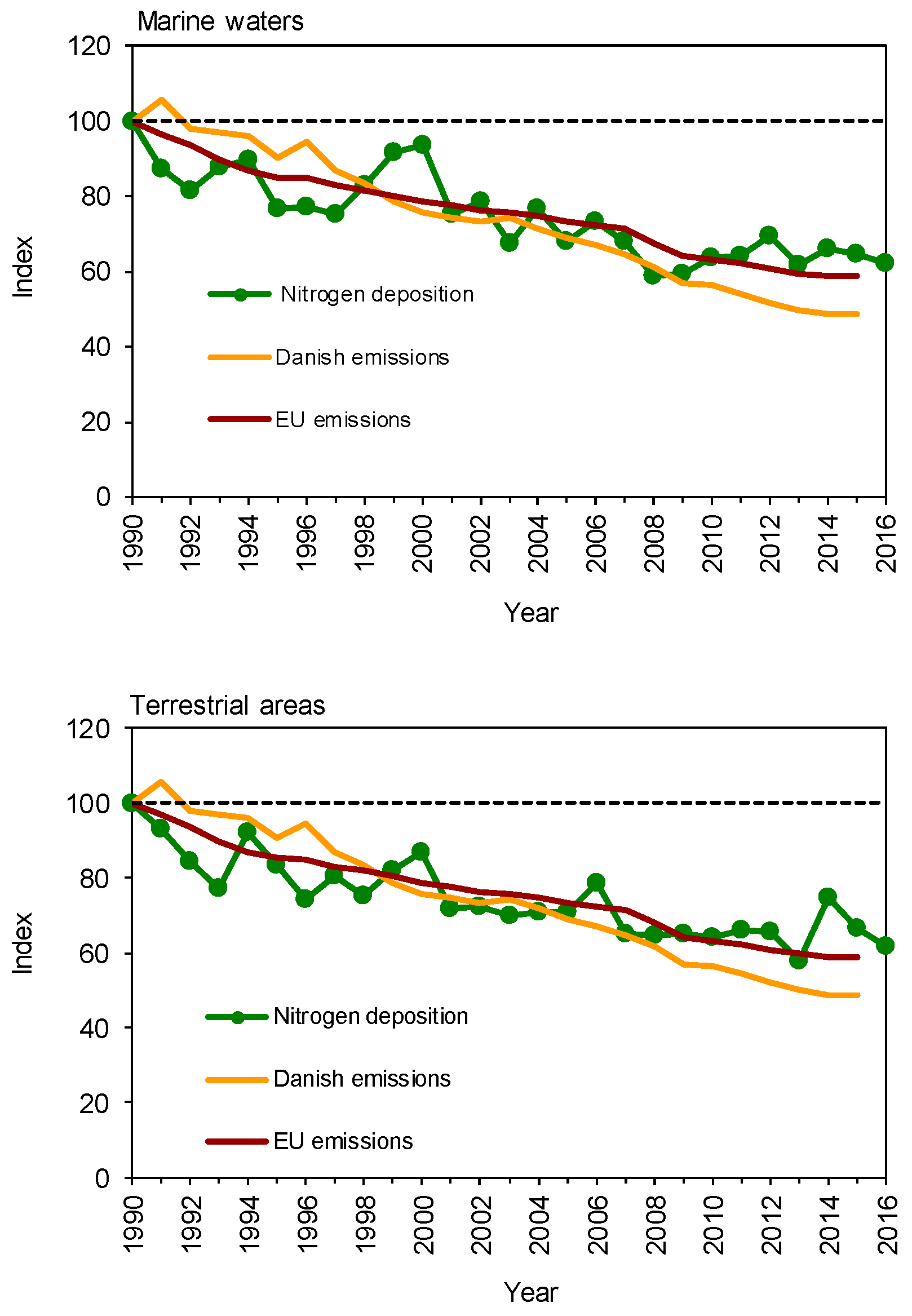

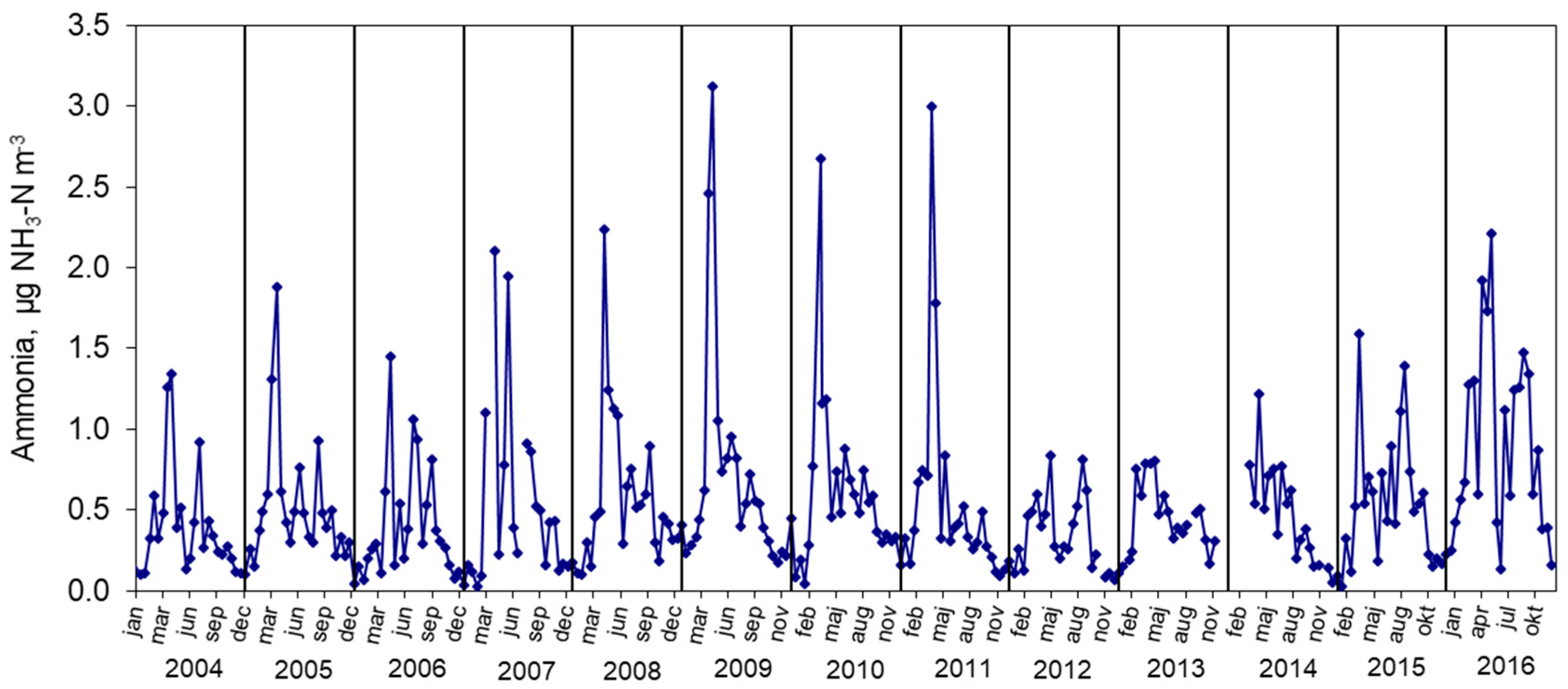
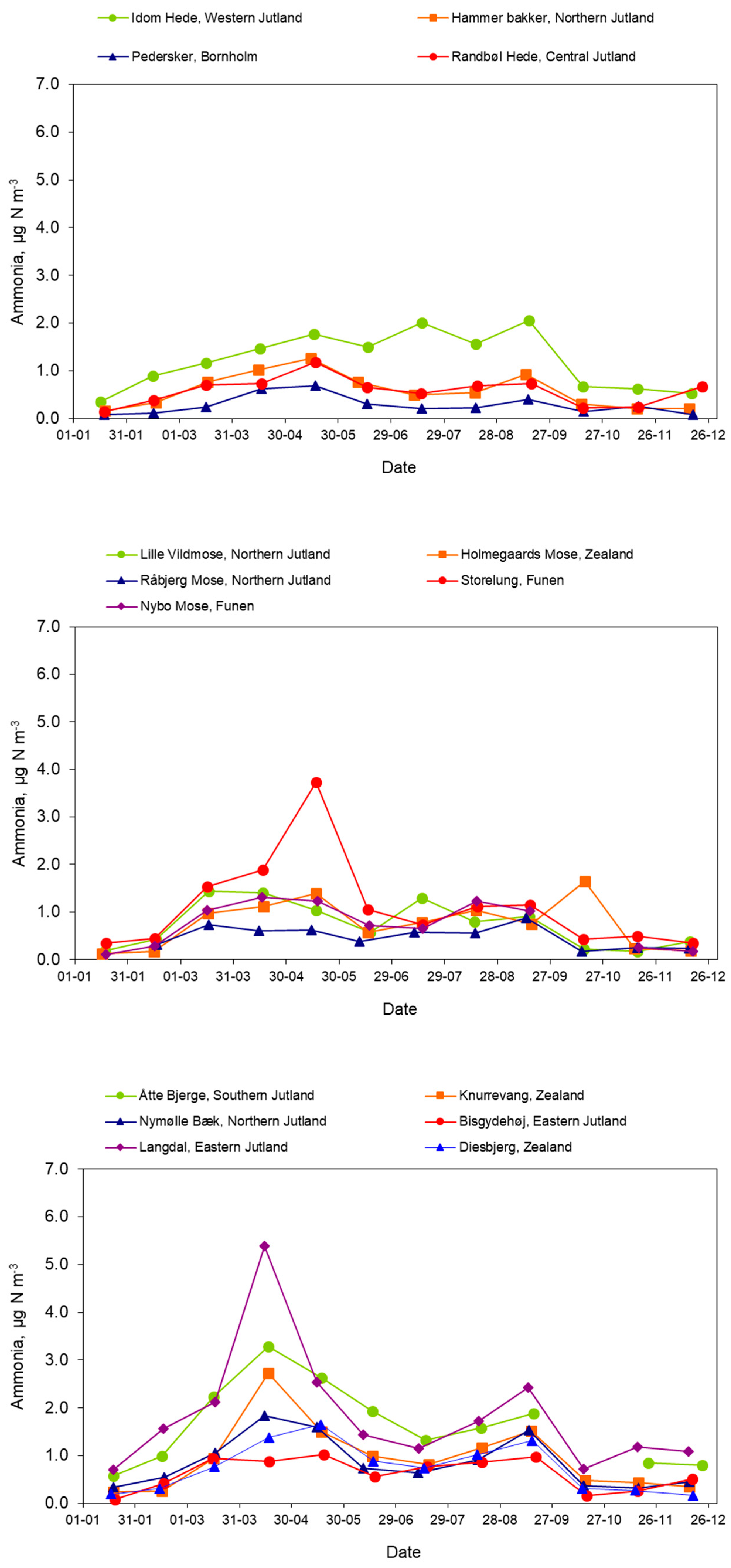
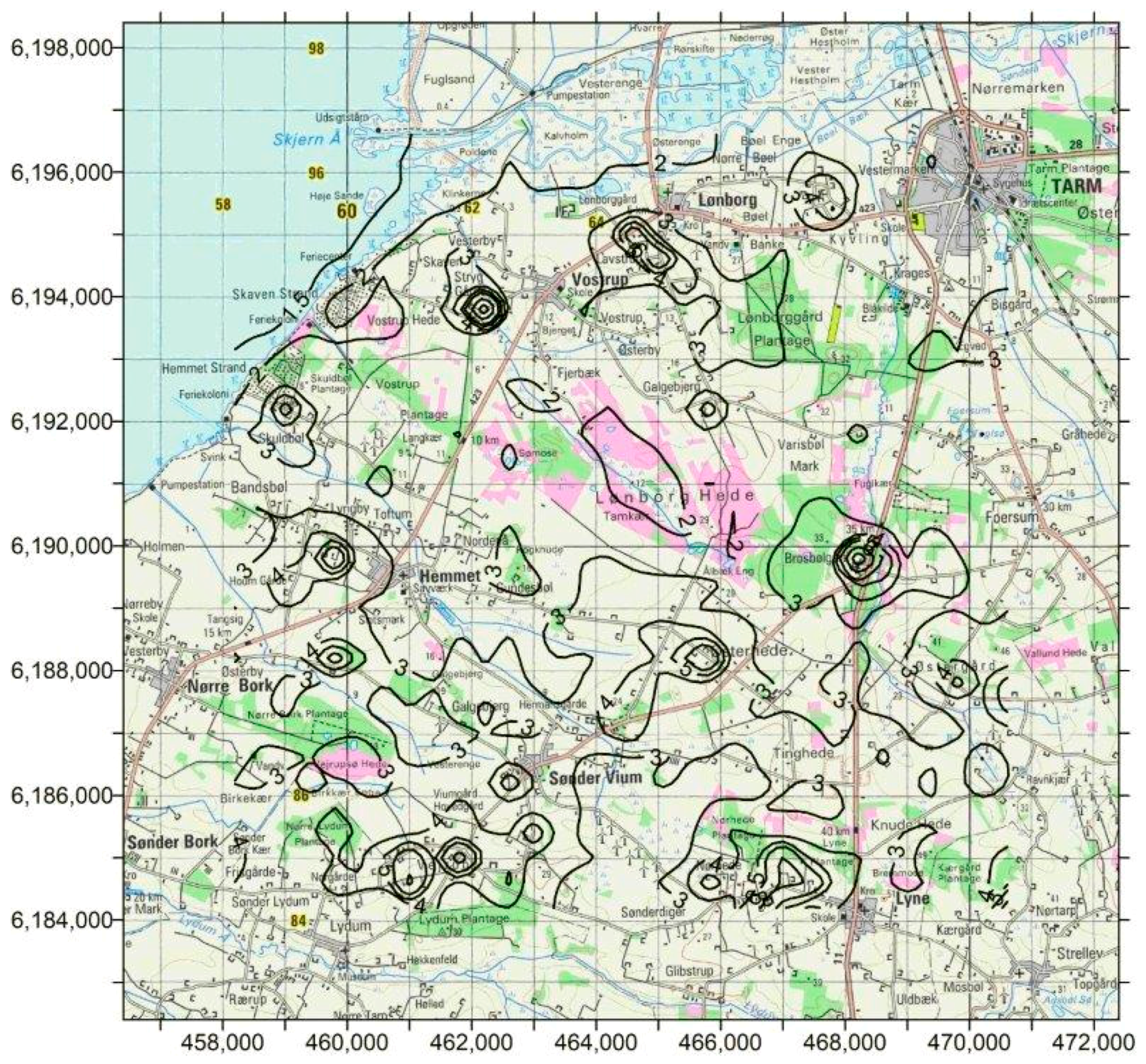
| Monitoring Station | Wet Deposition *** | Gas and Particles * |
|---|---|---|
| Anholt | Nitrate and ammonium | Filterpack, NOX monitor, Denuder |
| Keldsnor | Nitrate and ammonium | NOX monitor, Denuder |
| Lille Valby/Risø ** | Nitrate and ammonium | Filterpack, NOX monitor, Denuder, Passive sampler |
| Lindet | Nitrate and ammonium | Passive sampler |
| Pedersker | Nitrate and ammonium | |
| Sepstrup Sande **** | Nitrate and ammonium | |
| Tange | Filterpack | |
| Ulborg | Nitrate and ammonium | Filterpack, NOX monitor, Denuder, Passive sampler |
| Main Water | Dry Deposition (ktons N) | Wet Deposition (ktons N) | Total Deposition (ktons N) | Total Deposition/Area (kg N/ha) | Area (km2) |
|---|---|---|---|---|---|
| North Sea DK | 6.5 | 26 | 33 | 6.7 | 48,754 |
| Skagerrak DK | 1.1 | 5.6 | 6.8 | 6.5 | 10,329 |
| Kattegat SE | 0.8 | 3.7 | 4.4 | 6.6 | 6743 |
| Kattegat DK | 2.7 | 9.2 | 12 | 7.1 | 16,830 |
| Northern Belt | 0.7 | 2.3 | 3.0 | 7.7 | 3909 |
| Little Belt | 0.7 | 1.7 | 2.4 | 11 | 2171 |
| Great Belt | 1.0 | 3.0 | 4.0 | 8.9 | 4519 |
| Øresund DK | 0.2 | 0.8 | 1.0 | 7.3 | 1336 |
| Øresund SE | 0.1 | 0.6 | 0.7 | 7.3 | 950 |
| Southern Belt | 0.6 | 1.7 | 2.3 | 9.1 | 2547 |
| Baltic | 2.2 | 7.0 | 9.2 | 6.2 | 14,926 |
| Total Marine | 16 | 57 | 73 | 6.9 | 105,321 |
| Region | Dry Deposition (ktons N) | Wet Deposition (ktons N) | Total Deposition (ktons N) | Total Deposition/Area (kg N/ha) | Area (km2) |
|---|---|---|---|---|---|
| Northern Jutland | 4.4 | 5.2 | 9.7 | 12 | 7907 |
| Central Jutland | 7.8 | 9.8 | 18 | 13 | 13,093 |
| Southern DK | 8.4 | 10 | 18 | 15 | 12,130 |
| Zealand | 3.6 | 4.7 | 8.3 | 11 | 7268 |
| Capital area | 1.3 | 1.5 | 2.8 | 11 | 2567 |
| Entire country | 26 | 31 | 57 | 13 | 42,927 |
| Site | Nature Type | Annual Mean Ammonia Concentration (µg m−3) |
|---|---|---|
| Langdal (Eastern Jutland) | Dry Grassland (6230) | 1.8 |
| Åtte Bjerge (Southern Jutland) | Dry Grassland (6230) | 1.6 |
| Idom Hede (Western Jutland) | Dry Heath (4030) | 1.2 |
| Storelung (Funen) | High Bog (7110) | 1.1 |
| Lille Vilmose (Himmerland) | High Bog (7110) | 0.7 |
| Holmegårds Mose (Southern Zealand) | High Bog (7110) | 0.7 |
| Nymølle Bæk (Northern Jutland) | Dry Grassland (6230) | 0.9 |
| Knurrevang (Southern Zealand) | Dry Grassland (6230) | 1.0 |
| Nybo Mose (Funen) | High Bog (7110) | 0.7 |
| Diesbjerg (Sejerøbugten) | Dry Grassland (6230) | 0.7 |
| Bisgydehøj (Mols Bjerge) | Dry Grassland (6230) | 0.6 |
| Randbøl Hede (Central Jutland) | Dry Heath (4030) | 0.6 |
| Råbjerg Mose (Northern Jutland) | Quaking Bogs (7240) | 0.5 |
| Hammer Bakker (Northern Jutland) | Dry Heath (4030) | 0.6 |
| Pedersker (Bornholm) | Dry Heath (4030) | 0.3 |
© 2018 by the authors. Licensee MDPI, Basel, Switzerland. This article is an open access article distributed under the terms and conditions of the Creative Commons Attribution (CC BY) license (http://creativecommons.org/licenses/by/4.0/).
Share and Cite
Ellermann, T.; Nygaard, J.; Christensen, J.H.; Løfstrøm, P.; Geels, C.; Nielsen, I.E.; Poulsen, M.B.; Monies, C.; Gyldenkærne, S.; Brandt, J.; et al. Nitrogen Deposition on Danish Nature. Atmosphere 2018, 9, 447. https://doi.org/10.3390/atmos9110447
Ellermann T, Nygaard J, Christensen JH, Løfstrøm P, Geels C, Nielsen IE, Poulsen MB, Monies C, Gyldenkærne S, Brandt J, et al. Nitrogen Deposition on Danish Nature. Atmosphere. 2018; 9(11):447. https://doi.org/10.3390/atmos9110447
Chicago/Turabian StyleEllermann, Thomas, Jesper Nygaard, Jesper Heile Christensen, Per Løfstrøm, Camilla Geels, Ingeborg Elbæk Nielsen, Maria Bech Poulsen, Christian Monies, Steen Gyldenkærne, Jørgen Brandt, and et al. 2018. "Nitrogen Deposition on Danish Nature" Atmosphere 9, no. 11: 447. https://doi.org/10.3390/atmos9110447




